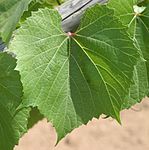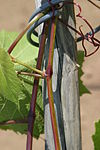Selection Oppenheim 4
| 'Selection Oppenheim 4' | |
|---|---|
| Synonyms | 'SO 4', 'Berlandieri x Riparia SO4', 'Berlandieri x Riparia selectia Oppenheim 4', 'Oppenheim 4', 'Oppenheim SO4'. |
| Breeding number | SO 4 |

|
|
| Art | Group: Berlandieri x Riparia crossing |
| use | |
| origin | Germany |
| known since | 1933 |
| breeder | Rességuier 1896 (F), selection Teleki (H), H. Fuhr, H. Rodrian Oppenheim am Rhein (today service center for rural areas ) |
| Breeding year | from 1920 |
| Launch | 1933 |
| VIVC no. | 11473 |
| ancestry | |
|
Hybrid of |
|
| List of grape varieties | |
The ' Selektion Oppenheim 4' ( SO 4 ) is a hybrid grape that was created by crossing the Euvitis species Vitis berlandieri Planchon and Vitis riparia Michaux and is used as a rootstock for the biotechnical control of the root aphid for grape varieties ( Vitis vinifera ) susceptible to phylloxera .
origin
In 1912, the then director Heinrich Fuhr (1870-1958) introduced descendants of various Vitis berlandieri × Vitis riparia seedlings by Sigmund Teleki (1854-1910) from Dvor to Germany at the teaching and research institute in Oppenheim am Rhein (today the Rural Area Service Center ) . Starting with this material, the selection of vine-tolerant rootstocks began in the 1920s. A breeding line stood out for its many positive properties. This own selection comes from the Telekische Zuchtreihe number 4 and was then called "Selektion Oppenheim 4" (or 'SO 4' for short). In 1933 it was recognized by the Reichsnährstand with the designation 'Berlandieri × Riparia Teleki 4 Selektion Oppenheim 4' ('SO 4'). In 1956 the rootstock received plant variety protection . When the plant variety protection expired in 1982, it was further processed in several domestic and foreign institutes. There are now a multitude of virus-tested clones. Since 1986 the institute for grapevine breeding and propagation has been the maintenance breeder of the Geisenheim research institute, specializing in grapevine breeding and refinement .
ancestry
Vitis berlandieri × Vitis riparia Teleki 4, selection Oppenheim 4.
Ampelographic features
- Shoot tip: half-open to open, bronzed to reddish brown-green and often with a whitish tinge.
- Young leaf: bronzed, silky gloss with reddish leaf veins, leaf surface covered with cobweb hairs.
- Fully grown leaves: Stalk bay U- to V-shaped, leaf blade glossy with blistered upper side, leaf underside with short-bristled hairs.
- Shoots: nodes purple-red, slightly woolly hairy.
- Tendrils: are predominantly three-part and slightly woolly hairy.
- Flower: male pseudo-hermaphrodite.
properties
The refinement affinity for all premium rice varieties is good and their root-forming ability is also satisfactory. Good callus formation occurs a little later with the refinement partners compared to Kober 5 BB . On average, nursery schoolers achieve a slightly lower yield in nursery schools. SO 4 tolerates up to 20% activated lime in the soil. With this property, SO4 is superior to the 5 BB for slow-growing noble varieties and narrow gaps. In less fertile, particularly dry locations, it is too weak in terms of vegetative growth, especially for high-yielding varieties. This also applies to vineyards with permanent greening and extensive cultivation. SO 4 is unsuitable for locations prone to drought. In the case of grape varieties that are sensitive to flowering, it reduces the risk of trickling. Their growth is medium and closes the growing season medium early. SO 4 promotes fruit set in almost all grape varieties while at the same time restraining growth. A high stick load and long stand lengths should be avoided.
use
'SO4' is by far the most important document variety in Germany. It has a certain distribution in temperate climates from Central Europe and also in the eastern states up to the Balkans.
literature
- Hans Ambrosi , Bernd HE Hill, Erika Maul, Ernst H. Rühl, Joachim Schmid, Fritz Schumann: color atlas grape varieties. 300 varieties and their wines. 3rd, completely revised edition. Eugen Ulmer, Stuttgart 2011, ISBN 978-3-8001-5957-4 .
- Karl Bauer: Viticulture (= AV specialist book. ). 8th, updated edition. Österreichischer Agrarverlag, Vienna 2013, ISBN 978-3-7040-2284-4 .
- Erwin Kadisch (founder): Viticulture (= the winemaker. Vol. 1). Edited by Edgar Müller. 3rd, completely revised edition. Eugen Ulmer, 2008, ISBN 978-3-8001-1241-8 .
- Jancis Robinson : The Oxford Wine Lexicon. 3rd, completely revised edition. Hallwag, Munich 2007, ISBN 978-3-8338-0691-9 .
- Joachim Schmid, Frank Manty, Bettina Lindner: Geisenheimer grape varieties and clones (= Geisenheimer reports. 67). Geisenheim Research Institute - Department of Vine Breeding and Refinement, Geisenheim 2009, ISBN 978-3-934742-56-7 .
Web links
- Selection of Oppenheim 4 in the database Vitis International Variety Catalog of the Institute for Grapevine Breeding Geilweilerhof (English)
- Geisenheim University, Institute for Vine Breeding
- Geisenheim University, Institute for Vine Breeding, Oppenheim 4 selection (PDF; 155 kB)
Individual evidence
- ↑ a b Hans Ambrosi, Bernd HE Hill, Erika Maul, Ernst H. Rühl, Joachim Schmid, Fritz Schumann: color atlas grape varieties. 300 varieties and their wines. 3rd, completely revised edition. 2011, p. 53.
- ↑ a b c Joachim Schmid, Frank Manty, Bettina Lindner: Geisenheimer grape varieties and clones. 2009, pp. 124-125.
- ^ Karl Bauer: Viticulture. 8th, updated edition. 2013, p. 97.




